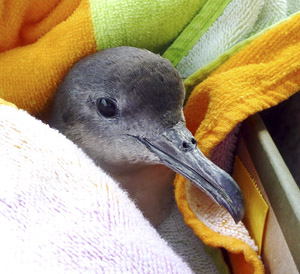Published in the Ocean Watch column, Honolulu Star-Advertiser © Susan Scott
November 11, 2013
This is the time of year to watch for wedgies, otherwise known as wedge-tailed shearwaters. If you rescue a wedgie, prepare to fall in love. These 16-inch-long seabirds have a natural smile on their beaks, velvet-smooth feathers, and after crash-landing, the exhausted and confused fledglings have a docile demeanor that seems to say, “Help me, please.”
Wedge-tailed shearwaters, also called uau kani, are ground-nesters. In spring, adults return from the ocean, where they’ve spent the winter gliding over the surface — “shearing” the water — searching for juvenile goatfish, flying fish, squirrelfish and squid.
A stranded wedge-tailed shearwater is kept
safe and comfortable wrapped in a towel.
©2013 Susan Scott
Like most of Hawaii’s seabirds, wedgies mate for life. After a couple reunites on land in spring, often with haunted-house-style moaning, the two get busy digging a burrow and raising a chick. Now, in November and December, the fledglings emerge from their burrows and fly away to sea.
Or not. Because the birds find the ocean by moonlight on the water, city lights cause some to fly the wrong way, where they hit houses, utility poles and cars.
The largest number of chicks crash in areas where human lights are brightest, such as in sports fields and near all-night stores and eateries glowing along our shores.
Some birds die, but others are only stunned and can survive if given a helping hand. If you find one of these downed birds alive, here’s what to do:
- This time of year, keep a clean towel or T-shirt and a ventilated cardboard box or pet carrier in your car.
- Using the fabric, gently pick up the bird from behind. Wrap the cloth loosely around its body and wings. Place the bird in the box in a quiet and cool location. Don’t feed, give water or try to release the bird yourself by throwing it in the air.
- Take your bird as soon as possible to Sea Life Park. After hours, there are outside boxes, checked each morning, in which to leave the bird.
- For researchers studying the light problem, leave a note with your wedgie reporting when and where you found the bird such as an address, cross street, utility pole number or mile marker.
OTHER WAYS TO HELP
- Turn off outdoor lights in November and December, especially if you live near the coast. If you have a necessary light, shield it so it only shines down.
- Volunteer at Sea Life Park to help care for the rescued birds. Email Christina Leos at cleos@sealifeparkhawaii.com for an application.
